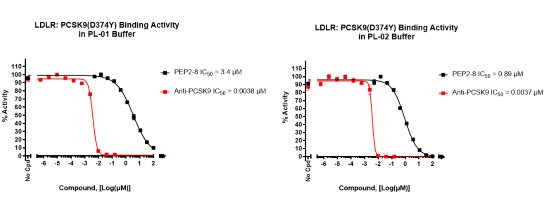PCSK9(D374Y) [Biotinylated]-LDLR Binding Assay Kit
The PCSK9(D374Y) [Biotinylated]-LDLR Binding Assay Kit is designed for screening and profiling purposes. The kit comes in a convenient 96-well format and contains enough biotin-labeled mutant protein PCSK9(D374Y), purified LDLR ectodomain, and HRP-conjugated streptavidin for 100 reactions. Moreover, two pre-formulated assay buffers are supplied to validate PCSK9-LDLR binding in either neutral or acidic binding conditions.
This assay takes advantage of the high sensitivity of detection of biotin-labeled PCSK9(D374Y) by streptavidin-HRP. First, a 96-well plate is coated with LDLR ectodomain. PCSK9(D374Y) is then incubated with LDLR. Finally, the plate is treated with streptavidin-HRP followed by addition of an HRP substrate to produce chemiluminescence, which is measured using a chemiluminescence reader.
Need us to run inhibitor screens or profile your compounds against PCSK9(D374Y)-LDLR? Check out our PCSK9 Screening Services.
- PBS (Phosphate Buffer Saline)
- Luminometer or microplate reader capable of reading chemiluminescence
- Rotating or rocker platform
| Catalog # | Name | Amount | Storage |
| 101725 | PCSK9(D374Y), Biotin-Labeled* | 10 µg | -80°C |
| 71205 | LDLR, FLAG-Tag* | 10 µg | -20°C |
| 79742 | Streptavidin-HRP | 10 µl | -20°C |
| 33298 | 3x PL-01 Assay Buffer | 50 ml | -20°C |
| 79727 | 3x PL-02 Assay Buffer | 50 ml | -20°C |
| 79728 | Blocking Buffer 2 | 50 ml | +4°C |
| 79670 | ELISA ECL Substrates A and B (2 components) | 6 ml each | Room Temp |
| 79699 | 96-well plate, white | 1 | +4°C |
* The concentration of protein is lot-specific and will be indicated on the tube containing the protein.
PCSK9 (Proprotein convertase subtilisin/kexin type 9) functions as a negative regulator of the hepatic low-density lipoprotein receptors (LDLRs) by binding to the LDLR ectodomain. The D374Y mutation is associated with severe hypercholesterolemia; this form of PCSK9 is more potent at decreasing LDL uptake than wild-type PCSK9, most likely by increasing the binding affinity of PCSK9 for LDLR.


